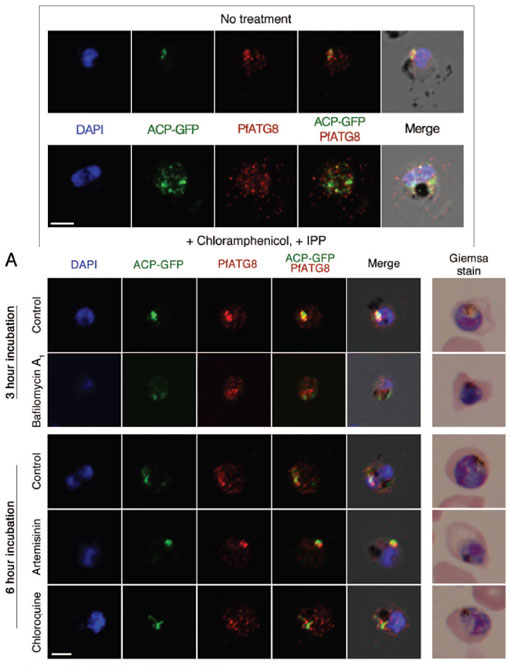PfATG8 immunofluorescent staining in apicoplast-minus malaria parasites. The integrity of the apicoplast in these parasites was lost using treatment with the antibiotic chloramphenicol. GFP-ACP parasite cultures were rescued by supple-menting media with isopentenyl pyrophosphate (IPP), the essential product from the non-mevalonate isoprenoid precursor pathway in the apicoplast. The large apicoplast PfATG8-labeled branching, as observed in untreated parasites, is disrupted into multiple foci in apicoplast-minus parasites. These foci show colocalization of GFP-ACP and PfATG8 vesicles, although additional PfATG8 vesicles can be observed in the cytosol. DAPI is used as a DNA marker in blue. Scale bar: 2.5 μm
A.PfATG8 immunofluorescent staining in 3D7 parasites treated with lysosomotropic agents and artemisinin. After 3 h incubation with 75 nM of bafilomycin A1, branching of the apicoplast is disrupted and multiple PfATG8 autophagosomes can be observed. Artemisinin treatment at a high concentration (25 μM) results in cell cycle progression arrest, and chloroquine treatment, at a concentration of 100 nM (IC80), causes disruption of the apicoplast integrity. DAPI is used as a DNA marker in blue. Scale bar: 2.5 μm.
Cervantes S, Bunnik EM, Saraf A, Conner CM, Escalante A, Sardiu ME, Ponts N, Prudhomme J, Florens L, Le Roch KG. The multifunctional autophagy pathway in the human malaria parasite, Plasmodium falciparum.. Autophagy. 2013 Nov 11;10(1).
Other associated proteins
| PFID | Formal Annotation |
|---|---|
| PF3D7_1019900 | autophagy-related protein 8 |
